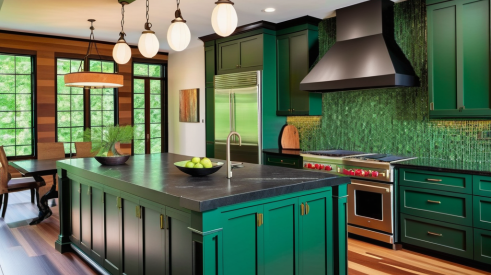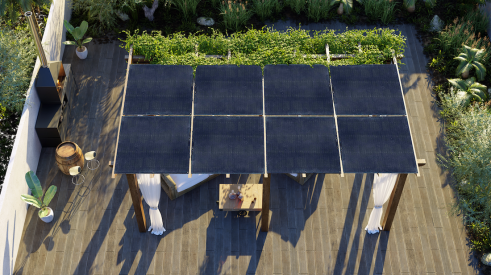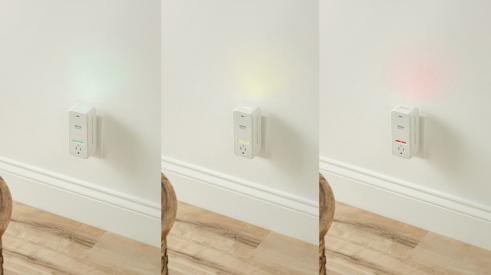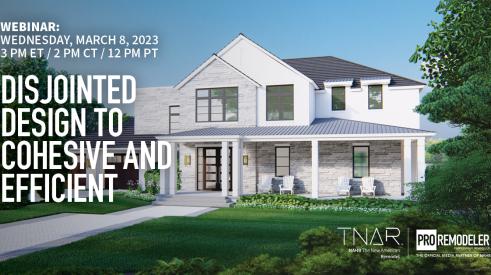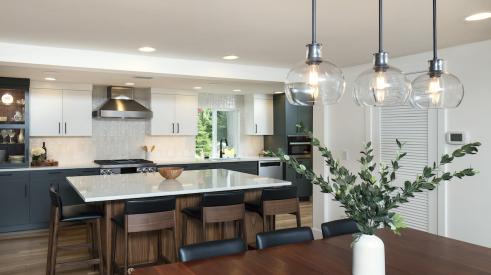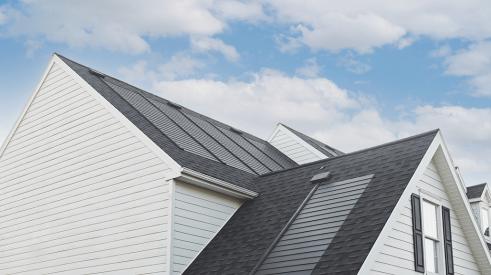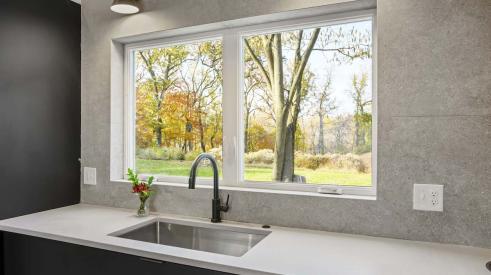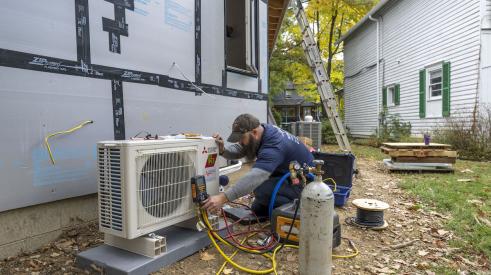|
 |
| Photo by Drew Kelly/Getty Images, photo illustration by Bonnie James |
2007 GREEN REMODELING SURVEY
As awareness of global warming has increased alongside energy bills of consumers, the remodeling industry's focus on green building practices has grown considerably, particularly over the last five years.
To find out exactly where the industry stands with relation to marketing, selling and producing green remodeling projects — as well as the impact it has on businesses — Professional Remodeler conducted a nationwide survey of a random sampling of professional remodeling contractors in June 2007.
The results revealed that remodelers are more focused on green than ever before, as 64 percent of respondents said green is important to their market strategy. They also indicated the lack of a universally accepted definition of green has led remodelers down many different paths in deploying green in their marketplaces. While nearly 90 percent of remodelers agreed that energy efficiency is an important ingredient of a green product, other traits such as durability and environmental impact were named by less than 50 percent.
We then took the data from our survey into the field and asked some of the nation's most experienced and educated green remodelers their opinions of the results. Here is what they had to say.
The lack of a universal definition of green is one of many issues affecting acceptance of green building practices in the remodeling industry. There are about as many definitions of green among all the associations, green organizations and green remodelers as there are shades of green in the color spectrum.
Not surprisingly, energy efficiency was named most by remodelers (88 percent) responding to our survey when asked what attributes make a product green. Not all green remodelers agreed it's the most important element, however.
|
|
"Green is the use of materials, products, design considerations and construction methodologies that result in the production of a healthier, lower maintenance and more energy-efficient home," said Michael Strong, vice president of Brothers Strong and GreenHaus Builders in Houston. "Those are the four keys for us down here. And we always say energy efficient last on purpose: 'by the way, it'll be more energy efficient.' We kind of throw that in. That's the free set of steak knives you get."
Other elements of green that are widely accepted in most definitions, such as renewable resources (72 percent), recycled content (71 percent) and reduced indoor off-gassing (55 percent), were considered less important to the majority of remodelers.
"Generally you want to use natural materials and materials that are close to your proximity so you're not shipping them from all over the world," said Chris Landis, co-owner of Landis Construction in Washington, D.C. "And then obviously using energy efficient assemblies or systems to heat, cool and do all the other things for the house just makes sense for the life-cycle costs. What you incorporate really depends upon the project, though."
The NARI green certification program defines a green remodeler as a remodeling professional who considers sustainability in maximizing nature's resources and energy in an efficient and responsible manner in the conduct of their business.
 |
Many long-time green remodelers take it even further, and regional differences and climates also come into play.
"We pay attention to durability, we pay attention to energy, we put a lot of attention on indoor air quality and the health of a building and the residents of a building," said Dennis Allen, owner of Allen Associates in Santa Barbara, Calif. "We also deal a lot here with water conservation, which is a scarce resource in California."
"I believe that being a green remodeler means more than just building green," said Tom Kelly, president of Neil Kelly in Portland, Ore. "It really entails taking into consideration the environment and the impact of our business on the environment in every decision that we make. And that stretches all the way from the smallest decisions that we make every day — if a carpenter at a job site plans a little better and doesn't drive to the lumber yard as often or have a delivery made as often, that's saving some carbon and also saving some money — to the biggest."
Remodelers on the Green Bandwagon
Clearly, remodelers are big believers in green building. More than three-quarters of remodelers said environmental goals are important when planning a project, and only 8 percent said they are unimportant.
"There are a lot of us out there who have a genuine concern for the environment," says Stephen Robinson, owner of R.E. Construction & Maintenance Services in New Castle, Ind.
There is a significant group, though, that still doesn't buy the hype. About 18 percent of the respondents to our survey agreed with the statement "Green remodeling is a fad."
| 79 percent of remodelers said there should be minimum standards of performance and sustainability before a project is green. Of those, 39 percent said they should be set by a government agency. |
"I just think, from talking to different people across the country, some people just don't see a need or a demand for it," says Chris Donatelli, co-owner of Donatelli Castillo Builders in San Jose, Calif. "A lot of times green remodeling gets lumped into global warming, and then it gets political."
Sometimes, the problem is that remodelers look at green as more complicated than it really is, says Larry Schaffert, president of Schaffert Construction in Myersville, Md.
"A lot of the things you can do are common, everyday technologies that make you more efficient, things that are common-sense building techniques, not just green," he says.
Robinson echoes that sentiment.
"Energy-efficient design and energy-efficient construction are the biggest part of being green," he says. "Who can argue with saving money for their clients?"
Even if remodelers do nothing else but embrace energy efficiency, it'll make a difference, Robinson says.
"At any level, you're making things better," he says. "Green doesn't have to be all or nothing."
How Important is Green to Homeowners?
 |
Most remodelers may be on board with green remodeling, but they're not convinced homeowners are there yet. Only 22 percent of remodelers say homeowners are willing to pay extra for green features.
"People want to do the right thing as long as they can afford it," Robinson says. "Baby boomers grew up wanting to save the planet; now here's an opportunity for us to do it."
Over the last year or two, the "tipping point" has occurred with rising energy prices and media attention-raising awareness with consumers, says Iris Harrell, president of Harrell Remodeling in Mountain View, Calif.
"There's a huge spilling out of interest that wasn't there a couple of years ago," she says. "Now it's in everyone's sights."
Energy efficiency is clearly the most popular aspect of green remodeling, because there is an obvious bottom-line benefit to the homeowner.
"They're looking for products that are going to reduce the need for energy," Schaffert says. "They're willing to spend a little more to get a more efficient product."
| 55 percent of remodelers said they define a green remodel in terms of whether it meets criteria established by a national certification program or local green building program. |
Other green features are popular with homeowners as well — even if they don't know it.
"If you ask them if they're interested in green, they say no," Harrell says. "If you start asking them about specific parts of it, though, like indoor air quality, they're very interested."
Homeowners are concerned about issues like clean air, long-lasting products and low maintenance, all parts of the green formula, she says.
"We can lead them quietly in this direction without having to announce that this is green," she says. "There's a myth out there that green costs more and is an inferior product, so it's our job to make those changes that don't affect the price or the quality of the work."
This uncertain relationship with the word "green" may explain one of the stranger set of results the survey revealed. In two separate questions, 64 percent of remodelers say green remodeling is important to their market strategy, but 66 percent said it has no effect on sales. Seemingly, the questions contradict each other, but perhaps the answer lies in looking toward the future instead of examining the present.
"Right now there's only a small group looking for green," Harrell says. "But five years from now, it's going to be a big selling advantage. We're just not there yet."
 |
Roadblocks to Green Remodeling
The cost of many green building materials compared to standard materials may have come down slightly over the years, but 75 percent of remodelers still cited cost as the No. 1 obstacle to building green.
Not so fast, says Allen, who has been building green for more than 20 years and points out that many green features can be incorporated at little or no additional cost.
"A lot of things that were super expensive or almost impossible to get are pretty close to being standard, certainly readily available and almost cost-effective," says Allen. "Some of the paints and adhesives and things that are either very low on out-gassing or even zero are not more expensive."
A whopping 91 percent of remodelers said incorporating green increases project price, while nearly half of those said the increase is more than 10 percent on average.
"It's no different than asking the question 'how much does quality cost?'" says Strong. "You can get quality at no additional price; you can get quality at an additional 5 percent, 10 percent or double the cost. It depends on the level of quality they can afford and that they're comfortable with paying for. That's what we need to get through to contractors and homeowners is that green is exactly the same thing. How much more does quality cost depends on how green you want it."
Sixty-five percent of remodelers claimed the lack of consumer demand for green prevents them from installing more green products in their projects.
"There's a very small percentage of consumers who are turned off by green and sustainability and so on, but that's getting smaller all the time, especially as Generation X has become more important in the remodeling marketplace," says Kelly. "Beyond that, there's a whole universe of consumers who, given the choice between a green product and a non-green product, if the price is the same will always choose the green product. They're probably the widest piece of the market. The third segment is made up of those who embrace green either for philosophical, political, idealistic or health reasons. And those folks will pay a premium — generally a reasonable premium — to choose green products. "Our experience is when the price gets extreme, it's just not gonna happen."
 |
Setting the Standards
One of the most confusing parts of the green movement is who should decide what's green. Clearly, remodelers don't know what to think either.
While 83 percent of our respondents agreed remodelers should have to meet minimum standards before calling a project green, they didn't agree who should be setting the standards. Almost 40 percent said it should be the government, 32 percent said third-party programs and 25 percent said trade associations.
"We need quantifiable standards, certainly, but I don't think there's one answer out there," says Carl Seville, who was a leader in developing Atlanta's EarthCraft program. "I have no particular objection to a government agency setting the standards if it's done correctly, but it's questionable if that can happen within the bureaucracy."
Whether or not a specific project is certified, it's equally important that remodelers are educated about what green is, says Seville, who ran his own award-winning remodeling firm for years before starting his current company, Seville Consulting.
"People need to be trained in order to build green," he says. "It's not easy, but those that are out there getting the information are going to have an advantage."
Trade associations like NAHB and NARI offer green certification programs now as builders and remodelers demand more information.
 |
The benefit of the certification is two-fold, says Donatelli, one of the remodelers who developed NARI's program.
"It gives the consumer a confidence level that you've been certified, but it also hopefully starts your brain working and gets you thinking about things in a different way," he says.
Unlike other NARI certification programs, the Green Certified Professional curriculum will constantly change as the field evolves. That means much of the class will be Web-based, which is also more green than constantly printing out new study guides, Donatelli points out.
And, he says, it's not surprising that the industry can't agree on one standard for green certification.
"Not everyone even agrees we should be doing this, and not everyone agrees on what constitutes green," he says. "People can't even agree to use the same building codes on a national basis, so I wouldn't think we could come up with one standard for green, either."
|
What exactly is green? And how are remodelers marketing and selling it to consumers?
Add new comment
Related Stories
Working Toward Affordable, Resilient Homes
A new natural disaster protection act from NAHB aims to support hazard mitigation projects
Client Design Choices in the Time of Social Media and AI
Social media speeds up the trend cycles, and now artificially created images are falling into homeowners' hands
Indoor Air Quality Gets Smart
A home's air quality can now be cloud connected and fully automated with this innovative product
Webinar: From Disjointed Design to Cohesive and Efficient—The New American Remodel 2023
Access the recording for the first The New American Remodel webinar held on March 8 at 2 pm CT
5 Standout Energy-Efficient Products Spotted at IBS 2023
See what this green remodeler recommends from the show floor
Innovative Products: GAF Energy Timberline Solar Shingles
GAF Energy’s latest innovation has taken the solar world by storm
Detailed Design: Benefits of Biophilism
See the details our Model ReModel contractors chose to infuse nature into their ADU
Heat Pumps Now Required in Washington New Construction
Washington is the second state to require heat pumps in an effort to electrify homes





